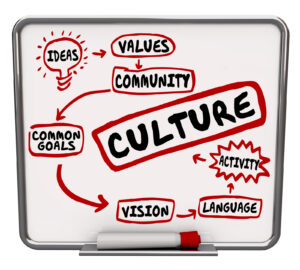Why Workplace Culture Matters, What Workplace Culture Is, and How to be Intentional About Workplace Culture
Why Workplace Culture Matters
As a leader in today’s rapidly changing world you must embrace your role as a culture champion and understand that everything you do and say as a leader either adds to your workplace culture or detracts from your culture. You truly are the orchestra conductor of your workplace who sets the overall tone of your culture.
You simply can’t separate your role as a leader from your focus on building a great culture: Great cultures don’t happen without great leaders, and conversely, great cultures produce great leaders.
Your culture also just happens to be your #1 competitive advantage and your #1 driver of success. I don’t care how big or small your organization is, or what your company does, culture amplifies your success and affects every aspect of your business.
A study (and there are whacks of studies that support the importance of culture – ‘whack’ being, I believe, the technical term) in Harvard Business Review found that how a company hires, trains, and treats its employees accounts for anywhere from 30% to 300% growth over their competitors.
When I’ve interviewed senior leaders around the world, one question I always ask is, “What’s been more important when it comes to your phenomenal success, your strategy or your culture?”
The vast majority (95% to be exact) of these senior leaders have answered, “It’s our culture.”
I’m not dismissing the importance of a potent business strategy. But without the right culture in place, chances are that even with a winning strategy you’re going to struggle, or at the very least, not be as successful as you might otherwise be.
And it’s critical that your strategy and culture are interlinked and congruent with one another. According to LSA Global, organizations that align their culture and strategy grow revenue 58% faster, are 72% more profitable, and employees are 16.8 times more engaged. So, you need to nurture the kind of culture that will drive your strategic goals and conversely your strategy needs to include an intentional focus on workplace culture.
Consider this: Someone down the road or, for that matter, halfway around the world, can undercut you on price and/or offer your employees more money. You’re unlikely to win these financial arms races, and chances are you can’t do much about it anyways, even if you wanted to.
Fortunately, there are many levers at your disposal that are far more powerful than money when it comes to attracting, retaining, and engaging employees.
And knowing that you can’t control outside forces, such as what your competitors are doing, it becomes that much more critical to relentlessly focus on what you can control: Your workplace culture.
Not only is your culture a competitive advantage when it comes to attracting and retaining top-notch employees, you can also view it as your competitive secret weapon. Your competitors might be able to “borrow” (yes, I’m being kind) your pricing structure, product offerings, or customer service strategies, what they can’t easily copy is a committed focus on workplace culture that differentiates you in a myriad of ways from your closest competitors.
Increasingly, employees are drawn to companies known for their positive workplace culture and whose culture matches their values. Employees will often choose an inspiring culture over higher wages: One study reported in the HP Work Relationship Index report found that 83% of people say they are willing to earn less if it means feeling happier at work. Conversely, employees are leaving their jobs like never before because of their leader or a dysfunctional workplace culture.
And if you truly want to hire the best employees, then keep in mind that if they really are the best employees they can work any darn place they please, so you need to promote your cultural advantage to attract great employees and spend as much time selling the benefits of working for you as you spend assessing new employees’ potential.
Once you’ve enticed those brilliant minds to come and work for you, you need to hang on to them! There is a difference between long-term employees and truly loyal, committed employees and that difference is realized through your workplace culture.
Truly loyal employees are more creative and innovative, more invested in helping your company succeed, and more productive than employees who are merely hanging around for a paycheck. It’s your culture that creates the conditions where employees are far more likely to demonstrate what’s known as “discretionary effort” – a willingness to go above and beyond the minimum expected requirements in their jobs.
Conversely, the cost of employee turnover is far greater than most organizations realize. And the cost of employee disengagement –the percentage of employees who report being disengaged are abysmal — please don’t make me repeat the stats here. And presenteeism rates, where people show up at work, but not necessarily to work, are equally alarming.
Stronger workplace cultures are also more resilient and have fewer costs related to employee absenteeism, burnout, and health-related issues.
Communication is markedly improved in an inspiring workplace culture, as is collaboration, teamwork, innovation, and the ability of employees to embrace change.
And all this ultimately funnels down into your ultimate drivers of success, including greater innovation, higher productivity, and remarkable customer service.
So, it should be clear, especially in today’s competitive dog-eat-dingo labor market, that your most important role as a leader is to foster an inspiring workplace culture that supports your business strategy.
But…and it’s a big but…you need to be intentional about your role as a culture leader because great cultures, as your grandparents probably warned you, don’t grow on trees. They don’t happen by accident. You can’t buy your culture at IKEA (even if you could, you wouldn’t understand the instructions and you’d likely have parts left over).
You need to work on your culture day in and day out, because, again, but with feeling, everything you do as a leader either detracts from or adds to your workplace culture.
So, What Exactly is Workplace Culture?
This seems like a good time to pause to consider the question: “What the heck are you talking about?”
If you are going to hire and train employees with your culture in mind, promote your culture, and measure your culture, then it seems kind of important to understand what it is you’re going to be intentional about!
Here are a few definitions of workplace culture to swirl around your brain:
- Culture is embodied in the “how” and the “why.” It’s why your company does the things they do and how everyone goes about doing them.
- Culture is the unique set of rituals, traditions, values, artifacts, and behaviors that define your unique work environment and make you different from your nearest competitors.
- Culture is defined through the small moments, day in and day out, that shape and reflect a sense of community at work.
- Just as you strive to create a positive customer experience for your customers, culture embodies the entire employee experience.
- Culture is reflected in how well employees feel a sense of belonging in your workplace; how well employees and teams collaborate; how psychologically safe employees feel bringing forward ideas and asking tough questions; how employees deliver memorable customer experiences; and how employees behave when no one is watching.
- Your culture is your collective mojo. Now, I have a confession: I don’t know how one measures mojo, but I think we all know it when we feel it and feel it when it isn’t there!
There are lots of ways to encapsulate the essence of culture, what’s important is that your team all have a common understanding of what it is you’re talking about when you speak about your workplace culture. The more clarity you have over what you mean by workplace culture and how you define your norms and values, the easier it becomes to communicate critical culture messages, live up to your cultural values, and measure your progress.
Many companies use a kind of internal shorthand to describe various aspects of their culture. Google, for example, uses the term “Googliness” to describe that hard-to-pin-down quality that Google recruiters look for in a new hire.
The software company Quicken has several “Quickenisms” that define their cultural norms in a shorthand way, such as, “It’s not about WHO is right, it’s about WHAT is right” and “You have to take the roast out of the oven” which translates to, “at some point you need to stop planning and start doing.”
The vocational rehabilitation company Agilec refers to their culture as a “Mullet Culture.” No, you don’t have to wear a mullet to work there, it’s their shorthand way of affirming that they are “Serious and professional in the front, but they like to have fun in the back!”
Taking the time to define some key elements of your cultural norms will do wonders when it comes to infusing some energy into your workplace and translating your intentions into action.
Here are some questions to mull over as you ponder how you might define your workplace culture and assess where your culture currently sits on the culture mojo scale.
What are your unwritten rules that guide everyone’s behaviors?
This is a question that can reveal hidden assumptions and uncomfortable truths. You might have unwritten rules about how ideas get passed up the chain, how failure is treated, or how employees interact with certain managers over others.
What do veteran employees tell the new kids on the block?
At the end of their first week, your new employee grabs a coffee or beer with some of the veterans, and grizzled old-timer Bob pulls out a pipe and says, “Hey kid, let me tell you what’s REALLY going on around here. I’ve seen things. Things I can’t unsee.”
Ideally you want everyone (especially the seasoned veterans) saying great things about your workplace culture and you want to have your pulse on what the seasoned employees are feeling and saying to your new employees.
Are employees raving ambassadors for your company?
One of the first questions we all get asked out in the wild is, “How’s work going?” Through their answers, your employees constantly reflect and shape your reputation and brand in your community. They’re also a powerful recruitment funnel for new employees, so the ultimate litmus test is this: Would your employees recommend your company as a great place to work to their best friend or a family member?
Do you match your hype?
Hop over to your website right now and have a gander at the “About Us” or career section. I bet it says your company is pretty darn awesome – the kind of workplace that is so fabulous employees spontaneously break into song and dance. But are you really living up to the values you say you espouse? Do you match your hype in your recruitment ads? What if your frontline employees wrote your recruitment ads or “About Us” section in a totally honest way?
If you could describe your current culture and your ideal culture in one word or a short phrase, what word would it be?
This isn’t an easy task, but soliciting feedback from employees with this question and musing it over yourself can be extremely insightful. If you can’t distill it down to one word, what slogan might best capture the essence of your culture? The company 1-800-Got-Junk, for example, uses the phrase “Blame-free culture” as a rallying cry to capture their most important cultural norm.
What’s your cultural advantage?
What makes you different from your nearest competitor? And I’m not talking about pay, perks, or ping pong tables. What is your workplace culture advantage that makes you the place employees want to work, and customers want to spend their hard-earned dollars?
How to Be Intentional About Your Workplace Culture
I’ll say it again: Great cultures don’t happen by accident. As a leader, you need to be consistently, relentlessly intentional about your culture. So, what does that look like?
- You need to promote your culture to the world. If you’re going to attract fantabulous employees who are a fit for your organization, then you can’t remain the world’s best kept secret – you need to shout your awesomeness from the rooftops!
It’s astounding how most company websites don’t say anything substantial about their culture. Sure, they’ll list their benefits and maybe toss in a casual nod towards their culture (“We like to have fun!”), but rarely do they define and celebrate their culture to the level they need to. Champion your culture on your website and on your social media channels, and as a leader, take personal responsibility for being a cheerleader for your culture whenever the opportunity arises.
- You need to hire with your culture in mind. You need to not just hire employees who are a “culture fit,” but employees who will help you shift your culture in the direction you want to move it. Hiring only for culture fit, while important, runs the risk of creating an approach where you only hire clones of yourself. And I get it, you are pretty awesome! Who wouldn’t want more of you? However, hiring clones is a surefire recipe for complacency and stagnation. As the old saying goes, “If two employees think alike, one of them is redundant.”
Mike Easton, the CEO and President of Argus, based in Winnipeg, Manitoba, captures the essence beautifully with his philosophy when it comes to hiring and building a great team: “Surround yourself with the same hearts, but different minds.” Translation: You want people around you who share similar values, but you need a diverse team of people who think differently and who bring fresh perspectives to your business.
Fortunately, I’ve written an entire book on this topic (it’s a quick read, with a very catchy title I must say) called, “Hire, Inspire, and Fuel Their Fire: How to Recruit, Onboard, and Train New Employees to Live Your Culture Out Loud” that has plenty of ideas on how to promote, recruit, and hire with your culture in mind.
- Onboard and Train for Your Culture. You need to invest in training not just new employees, but all your employees on what your cultural norms are. And no, I’m not talking about one hour every year, or a PowerPoint slide tossed into your onboarding slide deck. You need to truly invest, in a substantive way, in training for the things that matter to help bring your cultural values to life.
- Communicate Your Cultural Norms Relentlessly. I’ll have more on this later when we do a deeper dive into bringing your values to life, but for now, I want to remind you that as a culture leader you should never miss out on an opportunity to talk about your culture and remind employees why your values matter. You need to evangelize your culture and become the Chief Repeating Officer of your values and cultural norms. Create regular culture moments in your meetings, seamlessly blend cultural references into your presentations, and talk about your culture in one-on-one conversations with your employees.
- Hold your colleagues, employees, and yourself accountable when it comes to your cultural norms. Your culture is only as good as the worst behavior you tolerate, so you need to actively use your cultural norms and expectations as line in the sands against which you measure success and hold people accountable, which leads rather nicely to the last point (I so love it when a plan comes together).
- Make every decision with your culture in mind. This is a biggie, perhaps the biggest. You need to look at every decision through the lens of your culture and consistently ask:
“Does this option reflect our culture and will this help us move our culture in the right direction?”
 Michael Kerr is a Canadian Hall of Fame speaker who is known as one of North America’s top workplace culture experts and thought leaders. Michael Kerr is the author of 9 books, including, “Small Moments, Big Outcomes: How Leaders Create Cultures That Drive Extraordinary Results,” “The Jerk-Free Workplace: How You Can Take the Lead to Create a Happier, More Inspiring Workplace,” and “The Humor Advantage:Why Some Businesses Are Laughing All the Way to the Bank.” To find out how Michael can help you achieve extraordinary results, book a 30 minute Discovery Call Here.
Michael Kerr is a Canadian Hall of Fame speaker who is known as one of North America’s top workplace culture experts and thought leaders. Michael Kerr is the author of 9 books, including, “Small Moments, Big Outcomes: How Leaders Create Cultures That Drive Extraordinary Results,” “The Jerk-Free Workplace: How You Can Take the Lead to Create a Happier, More Inspiring Workplace,” and “The Humor Advantage:Why Some Businesses Are Laughing All the Way to the Bank.” To find out how Michael can help you achieve extraordinary results, book a 30 minute Discovery Call Here.








